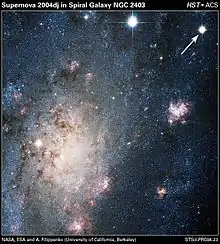SN 2004dj
SN 2004dj was the brightest supernova since SN 1987A at the time of its discovery.
 | |
| Other designations | SN 2004dj, CXOU J073717.1+653557, CXO J073717.0+653557 |
|---|---|
| Event type | Supernova, high mass X-ray binary |
| Spectral class | II-P |
| Date | 31 July 2004 18:15 UTC |
| Constellation | Camelopardalis |
| Right ascension | 07h 37m 17.044s |
| Declination | +65° 35′ 57.84″ |
| Epoch | J2000.0 |
| Galactic coordinates | ? |
| Distance | about 11,000,000 light-years |
| Remnant | Nebula |
| Host | NGC 2403 |
| Progenitor | Unknown star in compact cluster Sandage 96 |
| Progenitor type | Supergiant |
| Colour (B-V) | Unknown |
| Notable features | Light Curves |
| Peak apparent magnitude | +11.2 |
This Type II-P supernova was discovered by Koichi Itagaki, a Japanese astronomer on July 31, 2004. At the time of its discovery, its apparent brightness was 11.2 visual magnitude; the discovery occurred after the supernova had reached its peak magnitude. The supernova's progenitor is a star in a young, compact star cluster in the galaxy NGC 2403, in Camelopardalis. The cluster had been cataloged as the 96th object in a list of luminous stars and clusters by Allan Sandage in 1984; the progenitor is therefore commonly referred to as Sandage 96. This cluster is easily visible in a Kitt Peak National Observatory image and appears starlike.
External links
- Light curves and spectra on the Open Supernova Catalog
- supernovae.net image collection
- NASA Astronomy Picture of the Day: Cropped and rotated HST photograph (7 September 2004)
- Bright Supernova page on 2004dj
This article is issued from Wikipedia. The text is licensed under Creative Commons - Attribution - Sharealike. Additional terms may apply for the media files.